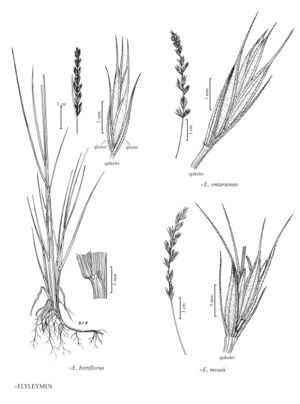Difference between revisions of "×elyleymus ontariensis"
imported>Volume Importer |
imported>Volume Importer |
||
| Line 36: | Line 36: | ||
|publication year= | |publication year= | ||
|special status= | |special status= | ||
| − | |source xml=https:// | + | |source xml=https://bitbucket.org/aafc-mbb/fna-data-curation/src/2e0870ddd59836b60bcf96646a41e87ea5a5943a/coarse_grained_fna_xml/V24/V24_494.xml |
|subfamily=Poaceae subfam. Pooideae | |subfamily=Poaceae subfam. Pooideae | ||
|tribe=Poaceae tribe Triticeae | |tribe=Poaceae tribe Triticeae | ||
Revision as of 21:51, 5 November 2020
Plants rhizomatous. Culms to 75 cm tall, 2-2.5 mm thick, clustered, glabrous. Leaves more or less evenly distributed; sheaths glabrous, smooth; auricles absent or to 0.3 mm; ligules about 0.5 mm, truncate; blades 10-25 cm long, 2-3 mm wide, involute, abaxial surfaces scabridulous, glabrous, veins not evident, adaxial surfaces smooth or scabridulous, glabrous, veins all equally prominent, apices narrowly acuminate. Inflorescences spikes, 8-12 cm long, 6-12 mm wide, with 1(2) sessile or subsessile spikelets per node; internodes 6-9 mm, partly exposed, angles hairy, hairs 0.4-0.6 mm; disarticulation above the glumes, beneath the florets. Spikelets 15-20 mm, with 3-5 florets. Glumes 9.5-16 mm long including the awns, 0.7-1.3 mm wide, lanceolate, widest about midlength, 3-veined, hairy or scabrous over the veins, awns 1-1.5 mm; lemmas 10-15 mm, hairy, hairs 0.3-0.4 mm, awns 3-7 mm; anthers about 2.8 mm.
Discussion
×Elyleymus ontariensis, according to Bowden (1967), comprises hybrids between Elymus trachy¬caulus and Leymus innovatus. It differs from ×Elyleymus hirtiflorus in having wider, more parallel-sided glumes and longer rachis internodes.
Selected References
None.
